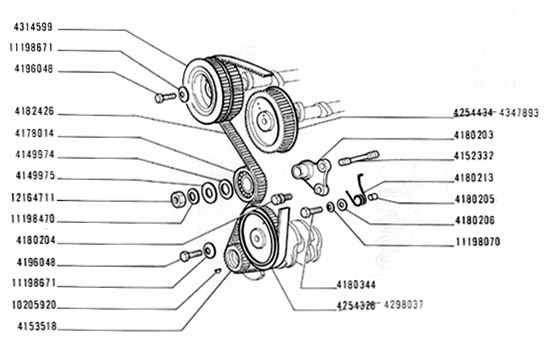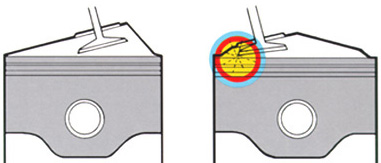 |
 |
 |
 |
 |
 |
The timing belt is a toothed rubber (it's more than just rubber, but that's another discussion) belt that keeps the crankshaft, aux shaft, and camshaft(s) in time with one another. It is critical if your engine is going to run, as an engine out of synchronization will lack compression, and the Ignition will not fire on time. Here's an illustration of the Belt on a Twin-Cam.

Yes, but as noted above this belt will cause your engine to quit, right now. Furthermore, unlike a water pump belt, this baby takes some time to replace, and is a highly specific part which you are unlikely to find at your average auto parts store. For the real reason you should replace it early, read on!
Q. I've heard horror stories about broken timing belts. What's the straight Scoop?
The biggest issue with failed timing belts on Fiats is the catastrophic
damage that can occur. When the engine is running with an intact belt, the
valves move up and down in time with the pistons, and the two objects
miss each other hundreds of times per second. When a timing belt fails on a
Fiat, the cams quickly spin to a stop, and the pistons keep going. If any
of the valves stop in the down position (statistically likely, almost
guaranteed) the piston will come up and deliver it a terrible whack.
At minimum, this means bent valves, and at its worst can knock a hole
in the piston. Or, if the belt breaks at high revs, the shattered
bits of Valve will bounce around in the combustion chamber, beating the
Cylinder head to death. These engines are called interference
engines for this reason (see figure), and if you break one you are most
likely in for a head job at minimum, and possibly lower-end repairs if the
damage is substantial. Why play roulette?

Well, possibly, but only if you are lucky. The 1500cc SOHC engines and
2000cc DOHC engines were built with dished pistons that will not bend
valves, but there are other issues. A lot of these engines have had
rebuilds that included flat or even special Domed high-compression pistons,
which will make them interference engines again.
Furthurmore, on the 2000cc Twin Cams, there is a more serious issue- If the
Auxiliary shaft stops in the wrong position, then the crank can come
around and whack the Aux shaft (aka Jack Shaft) and the results are
nasty.
At best, you will come away with a (hard to find) Aux shaft that has been
neatly blown in half by the much larger Crank, and at worst the impact will
knock the Aux shaft and it's housing right out the side of your Block. One
way or the other, the reasons for replacing your Timing Belt before it
breaks are there no matter what engine your have in your Fiat.
Q. OK, you convinced me. How often should the belt be changed?
Fiat says 36,000 miles, and I say 30,000. I like to allow myself a buffer
between maintenence periods (that top-down stuff is Heady, and even the most
dedicated Enthusiast is likely to forget the Interval). In actual use, the
belts last a lot longer than 36,000 miles, but... replace it anyway.
If you have no knowledge of the last replacement date/mileage on your new
Fiat, then replace the sucker. Now you know, and you can run the clock from
there.
Q. What else should I be aware of?
As long as you have the machine torn apart, take a good look at your Crank,
Aux, and Cam seals. If they show any signs of leakage, replace them
now. If your Engine leaks at these seals, the oil will soak the rubber
Timing Belt and cause it to fail far sooner than the recommended Interval.
Also, take a close look at the Tensioner Bearing. If it seems loose, noisy,
or suspect in any way, replace it.
Heck, if you can't name the last time
the Tensioner was replaced, now is the time to change it. I've seen them
fail in 50,000 miles, and I've also seen them run nearly forever... For
less than $50, you can assure that your Tensioner is OK, and I usually replace them every time I do a belt. It's cheap Insurance, and as I tend to
love my engines it's a small expense compared with the cost of a Failure.
Also, it's worthy to mention that you should never try to re-use a timing
belt. Once the belt has been tensioned and in service, it should be replaced
when it is removed.
This information is not intended to replace your Shop Manual. If you attempt replacement of this critical component yourself, please be sure that you understand the procedure, and have everything you need to accomplish the Job successfully!
As mentioned, the Timing Belt can be the undoing of your engine, so if you have any doubts about the Job you should read up, or have the replacement done by an expert.